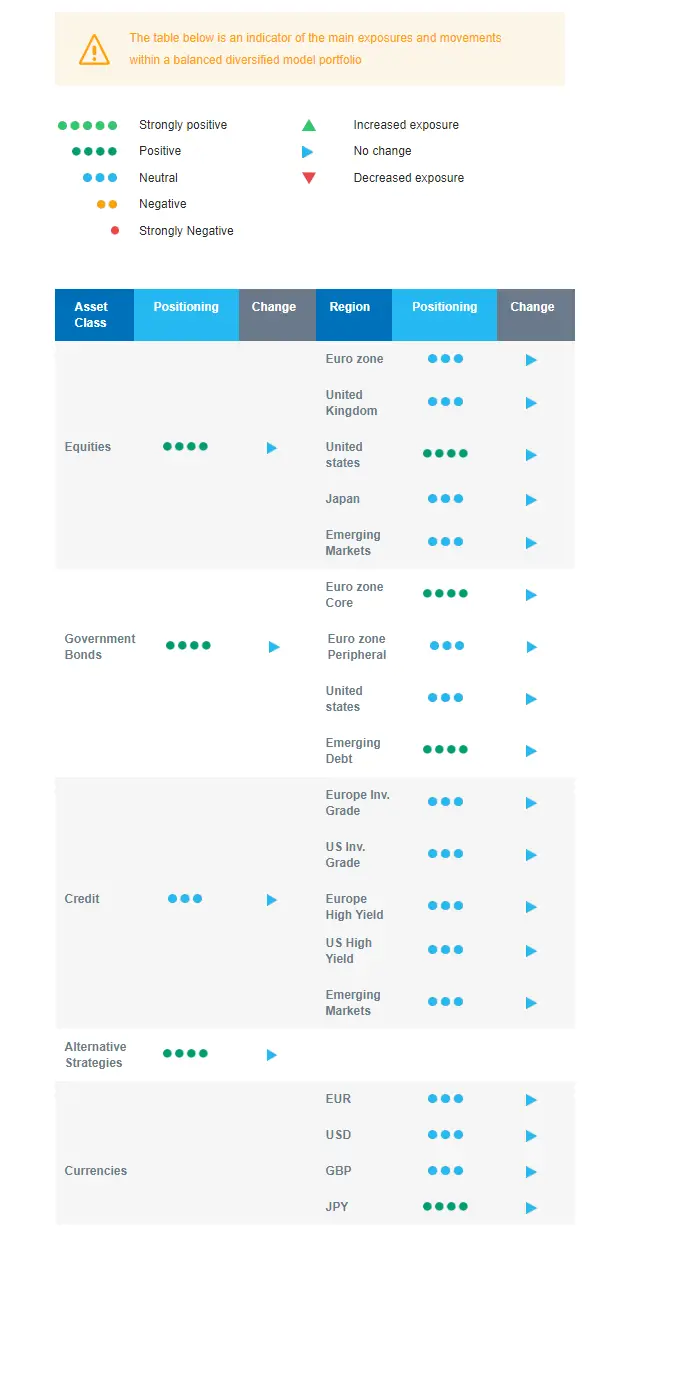Last week in a nutshell
- Consumer prices rose 3.4% in the 12 months to April, finally showing some signs of slowing. U.S. Yields retreated and equities went up.
- Fed Chairman Jerome Powell reassured investors, stating the market was getting comfortable with high-for-longer rates.
- In the euro zone, estimated figures of the GDP growth rate showed an expansion by 0.3% in Q1 2024, recovering from stagnation.
- The Japanese economy shrank by an estimated -0.5% in Q1 as consumers reduced their spending due to high costs of living and sluggish wages.
- The Chinese government announced the sale of special sovereign bonds paving the way for more policy support to boost weak credit demand.
What’s next?
- In the US, the FOMC minutes will be released, cementing the near-term monetary policy inclination of the Fed and Nvidia will report earnings for its fiscal first quarter of 2024.
- Several developing countries’ central banks are meeting, including Indonesia, Mexico, South Korea and Turkey. All face the dilemma of a strong US dollar in their need for being accommodative.
- Global flash PMIs due Thursday will be closely watched to gauge growth across key economies as inflation concerns ease. The UK and Japan will publish inflation readings too.
- In the euro zone, consumer confidence and the publication of new car registrations will enhance the conclusions of the ECB’s non-monetary policy meeting.
Investment convictions
Core scenario
- The US news flow is now at odds with Europe and China: weaker-than-expected economic data in the US is compensated by positive surprises in the latter regions. The good news is that the hawkish repricing regarding Fed rate cuts has likely run its course.
- In the euro zone, Q1 GDP data shows a bottoming out contrary to expectations of a quasi-stagnation. This activity pick-up from quasi-stagnation should represent a support for equity valuations. Forward-looking indicators undoubtedly point into that direction.
- Global disinflation trends have been confirmed by the most recent inflation data: from the decline in the price of Oil to April consumer price releases. At the current juncture interest rates have peaked and growth remains resilient.
- In China, economic activity has shown some fragile signs of stabilisation while the evolution of prices remain deflationary.
Risks
- An overshooting in US yields, the price of oil or the US dollar are key variables to watch. Geopolitical risks to the outlook for global growth remain tilted to the downside as developments in the Middle East and the war in Ukraine continues.
- Bond yields are to be monitored especially given the diverging paths taken by the US economy and its European counterpart.
- A stickier-than-expected US inflation while economic growth slows down too much and unemployment rises, could force the Federal reserve to reconsider its course.
Cross asset strategy
- We further increase our view from slight overweight to an overweight equity stance. The recent activity indicators and upcoming rate cuts might further support markets.
- We have the following investment convictions:
- We raise developed markets exposure ex-US, i.e. Europe and Japan, to slightly overweight.
- In the euro zone, we continue to add some beta and cyclicity to the portfolio to benefit from a broadening of the favourable environment: lower inflation than expected, higher growth than expected.
- In the UK, valuations are attractive.
- In Japan, exiting the multi-decade long deflation as well as corporate governance reforms bearing fruit should more than counterbalance a less dovish Bank of Japan.
- In the fixed income allocation:
- We prefer carry to spreads.
- We have reached the attractive entry point on US government bonds we were looking for as yields shot back up to 4.7% in April.
- We remain positive on European, including non-core European, duration. Upcoming cuts and easing inflation should be a support for the asset class.
- We lowered our exposure to emerging markets sovereign bonds amid very narrow spreads and a strong US dollar.
- We are neutral on investment grade and high yield bonds, regardless of the issuers’ region.
- In our forex strategy, we are positive on commodity currencies as the global manufacturing cycle picks up and have reduced our long position on the Japanese yen as the BoJ appears overly careful.
- We expect Alternative investments to perform well as they present some decorrelation from traditional assets and keep an allocation to gold.
Our Positioning
Our outlook on equity remains positive. We further increase our view from slight overweight to an overweight stance, with a preference for developed markets (US, Europe and Japan) to Emerging markets. With the addition of cyclicity to the portfolio, the strategy benefits from PMIs bottoming out and central banks cutting rates. The latter should act as a cap for long-term bond yields, underpinning our positive view on euro zone, peripheral euro zone, and US sovereign debt. We are neutral investment grade and high yield credits regardless of the region, as we prefer carry to spreads.

